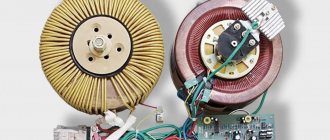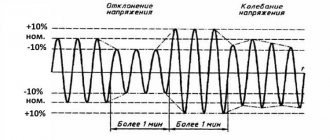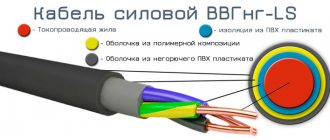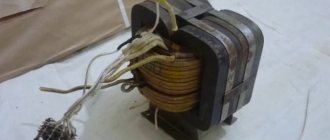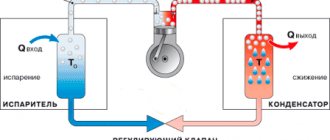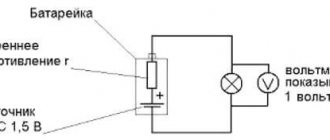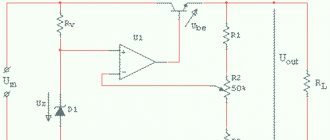Jumps, sudden disappearances of voltage in the network are familiar to everyone and, alas, not rare phenomena. Problems with the general deterioration of networks, line overload, or an electrician simply came and, without warning anyone, began to carry out some work on the general panel of the house - all this ends the same for the user - a sudden shutdown of all electrical appliances. To protect equipment and computer data, a voltage stabilizer or an uninterruptible power supply is used, which is not the same thing. They perform similar, but not at all identical functions. Let's take a closer look at their similarities and differences.
Do modern TVs need a stabilizer?
The issue of voltage stabilization for TVs has been around since the times when TVs were tube-based, and as the voltage changed, the picture on the screen was distorted. Often after such failures it was necessary to repair equipment.
All modern TVs are divided into the following main types: LED, LCD and plasma. Their peculiarity is that they are equipped with a switching power supply. Such units can operate in a fairly wide voltage range from 170 to 250 V. If such values are exceeded, the TV should turn off. If this does not happen, internal elements may burn out and then repairs will not be possible.
Some manufacturers, for example, LG and Samsung, produce specialized stabilizing devices. However, their cost significantly exceeds the cost of similar devices from other manufacturers.
And yet, is a voltage stabilizer needed for LCD or LED TVs?
If you constantly have power surges in your network, lights flash, and devices turn off, then in this case it is definitely worth installing a protective device. First you need to determine within what limits this happens. To do this, it is enough to measure the intensity level several times a day with a special tester.
Moreover, it may be better to install a stabilizing device on the entire apartment or house, which, of course, is quite expensive. But here we need to look at the circumstances. If equipment constantly has to be repaired, it is better to ensure network stabilization once, if its condition cannot be improved in any way.
The main stabilizer is installed as close as possible to the panel room, immediately after the meter
But such critical situations happen extremely rarely in urban electrical networks. This is more typical for rural areas. Therefore, there is usually no need to install a stabilization device, given its considerable cost. But if you are still worried about your equipment, but don’t know how to make a choice, it’s worth finding out what kind of stabilizing devices there are.
Another misconception is that pixels in TVs burn out due to increased voltage. Pixels are control transistors. And they can fail regardless of voltage. The same applies to a short circuit. If it does not occur in the device itself, then the power supply to the TV will simply stop, and the stabilizing device will not help in this situation. Moreover, this does not affect the operation of household appliances.
Sometimes you can come across a recommendation to purchase an uninterruptible power supply, which ensures the operation of the equipment in the event of a power outage. For TVs, this measure is not necessary at all.
Why do TVs burn during power surges?
If a person lives in a city apartment, then he is unlikely to be concerned about power surges. Therefore, many people believe that purchasing a stabilizer is a waste of money and is not needed for a modern LCD TV. But when a citizen lives outside the city in a rural area, the quality of electricity there is completely different. Frequent power surges occur there, which can become critical for any TV, even the most modern one.
For this reason, power supplies are protected in the form of a fuse, which easily melts when the set load is exceeded. Using this technology, you can leave important components of the TV out of reach if a large power surge occurs. But the safety mechanism itself will burn out, since it is disposable. And the TV will still not work until the faulty power supply is replaced. Increased voltage in the power supply of a Rolsen TV (or any other model) will lead to equipment failure. It is important to note that a burnt element cannot be restored. To prevent the TV from burning out in this way, you need to purchase a voltage stabilizer. Otherwise, the TV device will have to be constantly turned off if there is even the slightest hint of fluctuation in the network.
Tips for selecting stabilizers
Despite some functional advantages, installing a UPS that is more expensive than a stabilizer may not always be advisable. This is explained by the fact that voltage fluctuations occur constantly in the network, especially in the private sector, and accidents with a complete loss of power supply are quite rare.
For the normal functioning of most household appliances, it is sufficient to maintain the mains voltage at 220 V. Purchasing a stabilizer for this purpose is a more economical solution than using a UPS. Also an important factor when installing equipment in a city apartment or small office is the absence of a battery module stabilizer in the design and, as a result, smaller dimensions, which can significantly save occupied space.
Do not forget that when placing the UPS in cramped and poorly ventilated rooms, users may experience overheating and subsequent battery failure. In addition, overheating is also dangerous due to possible spontaneous combustion of battery cells, so it is not recommended to leave such equipment unattended for a long time. Stabilizers, when used correctly, guarantee almost 100% fire safety.
When selecting a stabilizer, you should pay attention to three main parameters: the number of phases, input voltage range and output power.
Single-phase stabilizers are used for networks in which the voltage is 220 V. These are mainly household networks in the residential and office sectors. Three-phase stabilizers are designed for three-phase networks; they are recommended for use to protect communication systems, powerful equipment and industrial facilities.
The choice of output power directly depends on the type of load. A separate aspect is electric motors, the starting currents of which are several times higher than the rated ones, and despite the fact that most stabilizers allow short-term overloads, when connecting an electric motor it is advisable to take an increased power reserve.
Old tube TVs
The adult generation remembers very well that in the USSR under every TV there was a plastic box called a “voltage stabilizer” that was sure to hum. The box, as a rule, was hot and necessarily heavy.
Of course, TVs could work without these boxes, but any deviation of the voltage in the outlet from 220V led to the image on the screen changing its brightness and saturation, and the picture itself changing in size. So almost everyone had stabilizers.
Such stabilizers worked using the principle of supersaturation of the transformer core and therefore were designed for a narrow range of load powers .
For black-and-white TVs with a power of 100-200 W, some models of stabilizers were produced, and for color TVs - completely different, more powerful ones. It was impossible to include a low-power load in a powerful stabilizer, because in this case, the very principle of its operation was violated and it ceased to perform its function.
Here, for example, is an excerpt from the instruction manual for the Soviet Vega-9 voltage stabilizer:
Allowable output power of the stabilizer: - minimum 100, - maximum 200 W.
Permissible input voltage fluctuations are 154…253 V. Stabilized output voltage is 198…231 V.
Efficiency - 84%. Stabilizer weight 3.4 kg.
As you can see, there was a limitation on the load power from below, i.e. It was impossible to turn on a small black-and-white TV with a power of less than 100 W in such a stabilizer. More precisely, it was possible to turn it on, but in this case one could forget about any voltage stabilization.
If you plug a load of more than 200W into Vega-9 (for example, a color TV of those times), then the stabilizer is guaranteed to overheat and the plastic case begins to melt and stink. I have seen such melted boxes from other people more than once.
By the way, today such old stabilizers for old TVs are called ferroresonant. Today's devices are often assembled using an autotransformer circuit with a large number of taps and triac switching between them.
Design features
Products using double energy conversion have a number of specific design features. Let's look at them using the example of UPSs and stabilizers from the Shtil brand, which is one of the leaders among Russian manufacturers and suppliers of power supply systems.
The main difference between these devices and devices of other types is the absence of an autotransformer and any moving (electromechanical) parts in the power circuit. Instead, the online UPS and inverter stabilizer include the following components:
| Component | Description |
| Input and output filters | Smoothes out electromagnetic interference and ensures compliance with EMC (electromagnetic compatibility) requirements. The input filter also protects the load from surges. |
| Rectifier with built-in power factor correction (PFC) | It works on the basis of rectifier diodes, thanks to which the alternating voltage supplied to the input is converted into direct voltage (let's call it intermediate). Thanks to the presence of the PFC, it compensates for the reactive component of the power of connected devices and provides a sinusoidal shape of the consumed electric current for any type of load. |
| Charger (only used in UPS) | It operates in parallel with the rectifier and converts the input AC voltage into the DC voltage necessary to charge the batteries. Note! In a UPS, the DC intermediate voltage and the DC voltage of the batteries are not equal. |
| Storage capacity | An important element that buffers energy and eliminates instantaneous changes in the output voltage when the input voltage fluctuates, which ensures consistently high quality of electricity transmitted to the load. In a UPS, this capacity allows you to power the connected equipment directly from the network, despite the deviations that occur in it, which reduces the number of switches to batteries (range of maximum input values 90-295 V). |
| DC/DC converter (used in UPS only) | Changes the value of the DC voltage taken from the batteries to the value of the intermediate DC voltage required by the inverter. |
| Inverter | Converts the direct intermediate voltage received from a rectifier (in the case of a stabilizer) or a rectifier or DC/DC converter (in the case of a UPS) into an output alternating voltage with a sinusoidal shape and nominal value. |
| Digital Signal Microcontroller | Performs automatic control of the energy conversion process using PWM control. Continuously monitors and adjusts the main output parameters of the device. |
Below are the block diagrams of the inverter stabilizer and online UPS:
Modern TVs and stabilizers
All modern household appliances, including TVs of the 3rd generation and newer, have switching power supplies capable of operating in a wide range of input voltages.
On imported TV models released after 2000, something like 110-260V AC is usually written on the back cover. At the same time, a stable voltage is always maintained at the output of such a power supply, which powers all components of the TV.
So, if your TV was manufactured after 1985 (not to mention models from 2017), then it does not need a stabilizer at all . Leave it in the store.
And don’t listen to the convincing assurances of TV sellers that a stabilizer for your new TV is simply absolutely necessary. The seller has only one task - to sell you as many extras as possible for your TV.
Short circuit and pixel burnout
He will tell you tales about how LCD TVs “burn out pixels” from power surges, how LED TVs burn out LEDs, how stabilizers protect your TV from short circuits, interference, direct hits from nuclear weapons, and other nonsense. Don't listen!
A short circuit will do absolutely nothing to your TV (unless, of course, the short circuit occurs in the TV itself). In the event of a short circuit somewhere on the line, the current will simply flow along a different path and the TV will be de-energized (i.e. it will simply turn off). That's all the terrible and terrible consequences of short circuit.
As for pixel burnout, I have the following to say. Firstly, the “pixels” themselves do not burn out at all; the control transistors that “light up” these same pixels fail. If the transistor burns out, the pixel remains extinguished forever (black dot), and if the transistor breaks, then the pixel always glows (bright dot on the screen).
The most interesting thing is that it doesn’t matter whether you have a stabilizer or not, pixels can and will fly out. This happens simply according to the theory of system reliability (just imagine how many of them there are, these pixels!).
Since we are talking about pixels, this means that this is an LCD TV, which means it has a switching power supply, therefore, voltage surges in the network do not have any effect on the voltage in the TV circuit itself.
In this way, voltage stabilization is already carried out inside the TV circuit, therefore, buying another stabilizer is nothing more than a waste of money.
The outlet voltage is too low or too high
You may ask, what happens if the voltage in the network goes beyond the permissible values indicated on the TV nameplate? It's simple. If the voltage gets too low , the TV will simply turn off. Without consequences. After the voltage returns to normal values, the TV can be turned on again as usual.
It's worse if the voltage gets too high . Then a breakdown of a special element at the TV input - a varistor - will occur. A broken varistor causes a real short circuit, as a result of which the fuse blows and the circuit is de-energized. This is overvoltage protection. After some time, the varistor returns to normal; all that remains is to replace the fuse. By the way, self-resetting fuses are now used.
So, as you can see, a modern TV provides protection against all major dangers. There is absolutely no point in buying a stabilizer specifically for TV.
Network filters
The only thing your TV may need is a good surge protector . And even then only in some cases. All switching power supplies already contain an RF filter at the input (this, by the way, is done to ensure that high-frequency interference from a working pulse generator does not penetrate the network and interfere with the operation of other electrical devices), but sometimes it is still not enough. And then an external surge filter will help get rid of interference.
However, here you need to be sure that interference penetrates into the TV through the power supply circuits, and not through the antenna, for example. In the latter case, the surge protector will be completely useless; it is better to focus on finding a high-quality antenna with good side-lobe suppression.
Uninterruptible power supplies
an uninterruptible power supply in addition to the TV . But you and I are smart, we know that uninterruptible power supplies are designed to maintain the functionality of equipment in the event of a power outage. They are indispensable for devices such as desktop computers, some medical equipment, network equipment from providers, etc. But why do TVs need uninterruptible power supplies?! So that you can finish watching the comedy club or what? A very dubious waste of money.
Does your computer need an external surge protector?
At first glance, the most reliable solution suggests itself - first a network filter that protects against interference, then a stabilizer, then an uninterruptible power supply, and only then computer equipment.
Despite all the external attractiveness of this scheme, some of its elements may turn out to be unnecessary.
Let's start with the surge protector. There is usually a varistor at the input that limits short-term high-voltage pulses. A varistor is a semiconductor element with a nonlinear current-voltage characteristic, which has a high resistance at a rated or slightly increased supply voltage, but instantly “shorts out” when a short-term jump of several kilovolts occurs.
As you can see, the operation of such a simple element as a varistor can protect expensive equipment from damage. But it is precisely the simplicity and low cost of the protection circuit with a varistor that has led to the fact that such protection is built into all computer power supplies, thereby eliminating the need to duplicate this part of the circuit with an external filter. In addition, a high-frequency noise filtering circuit with a choke and capacitors is built into the power supplies of computers and other office equipment. Only the most unscrupulous manufacturers do not install such filters.
Types of stabilizers and their features
Stabilization devices must provide protection for household appliances from power surges. But first you need to understand what types of these devices exist in order to understand which ones are best suited for your purposes.
Networks can be single-phase (220 V) or three-phase (380 V). Accordingly, these devices can also be divided according to this principle. Three-phase ones are more often used in industry, but single-phase ones are sufficient for private houses and apartments.
Voltage stabilizers can be divided into the following types:
- Relay;
- Electromechanical;
- Triac;
- Double conversion.
Now about each of them in more detail.
Relays are the most affordable in the price segment, which is why they are often used. They are able to withstand not very high differences and quickly convert the output voltage. They wear out the faster the more often jumps occur. Can be noisy and have a short lifespan.
Electromechanical or servomotor stabilizers. They have better characteristics than the previous ones and a higher cost. This device is a transformer that independently regulates the voltage on the supply loop. Among the advantages it is worth noting:
- Wide input voltage range and no output distortion;
- Silence;
- Virtually insensitive to operating frequency.
The disadvantages include:
- Moving elements need to be replaced every few years, the servo drive of the brush block - a little less often;
- The stabilization speed is lower than that of relay ones;
- Single-phase ones can only work in heated rooms.
Triacs have a long service life and are quiet. They do not require special maintenance, but their cost is even higher than that of electromechanical ones. Very fast stabilization speed. At high temperatures they may fail.
The most expensive stabilization systems are double conversion. They are capable of converting alternating current into direct current and vice versa, that is, they work as inverter devices. Such stabilizers are perfect for equipment with high power up to 30 kW and sensitive to voltage surges. They are durable and quickly respond to changes in network intensity.
Relay
Perhaps the most popular of all types. The device is inexpensive. The average price is 3,000 rubles. Relay type devices can withstand a 15% voltage surge. This type is most widely represented on the Russian market. Its main disadvantages include noise during operation and fairly rapid wear.
Mechanical
Equipment of this type is more expensive – about 6,000 rubles. Mechanical stabilizers are also noisy during operation and can fail at low temperatures. But, nevertheless, in terms of technical characteristics, this type is superior to the relay type. In case of large voltage drops, it will also not save the TV.
Triac or electronic
This type of voltage stabilizer is more reliable. Its work is based on the operation of electronic keys - triacs. Such devices are silent, very reliable and do not require additional maintenance. They cost about 10,000 rubles.
Double conversion or inventory stabilizer
This is the most reliable device to date. The average price is 35,000 rubles. But she justifies herself. The device is absolutely silent, works without interruptions and guarantees stable operation for a long time. The inventory type can withstand high amplitude power surges.
Stabilizer for boiler (inverter)
At the moment, this is the most advanced stabilization technology, more and more manufacturers are releasing corresponding models, we will focus on the most popular.
Shtil InStab IS1000
— inverter model with a power of 1 kVA (~ 700 W), operating range 110 - 290 V, error 2%, provides absolute protection against voltage surges and sags, electrical interference and distortion of the sine wave shape, providing electrical appliances with optimal voltage with a symmetrical sine wave (Fig. 2.).
Price approximately 10,500 rubles.
, example →
Fig.2. The appearance and contents of Shtil InStab IS1000 differ significantly from previous stabilizers (relay), the operating principle is discussed in detail here.
Video review of the work of Shtil Instab 500 with oven, kettle and boiler BAXI ECO Four 24
In the video, the author clearly demonstrates the operation of the stabilizer and describes the experience of using it with the BAXI ECO Four 24 boiler, and also gives a personal recommendation whether or not to buy this model. Note: previously the line included the Shtil Instab 500 model, as in the video, but when the model range was updated, the Instab 550 began to correspond to it.
Is it worth buying
Many new TV models already have built-in stabilizers, so-called “autovoltages”. They protect the electrical network from interference created by the device itself. But it does not protect against general power surges in the network.
All modern household appliances, especially new generation TVs, are equipped with switching power supplies. They continue to function over a wide input voltage range. Their instructions for use indicate the voltage amplitude at which no damage to the device will be caused. Typically it varies from 110 to 250 units.
REFERENCE! If the voltage supply to the outlet is irregular or its value is unstable, you should expect two scenarios.
The first is that the input voltage is too low. If the voltage is too low, the TV will simply turn off. Emergency cessation of work will not entail any consequences. As soon as the voltage returns to the operating range, you can use the device again.
The second option is a voltage surge above the permissible value. This is the worst option. In such cases, a special element built into the TV input - a varistor - is damaged.
A varistor is a semiconductor resistor. Its operation and stability completely depends on the input voltage. A sudden voltage surge above the desired level will lead to a short circuit.
When the varistor is damaged, the fuse blows and the TV circuit is deactivated. A damaged fuse can be replaced, and the circuit itself will autonomously return to working condition after some time. But excessive overload inside the device will each time worsen its performance and performance.
Do all TVs need “stability”?
The question of purchasing a 220V voltage stabilizer for a TV has been around since the days of large tube models. With each current surge, the image on the display deteriorated, became distorted, and the color changed. Often after a thunderstorm it was necessary to repair or send the TV for repairs.
Modern technology based on matrices such as LED, LCD and plasma is equipped with a switching power supply. It supports current drops in a fairly wide range: from 170 to 250 V. As soon as the values go down or up, the TV automatically turns off. But, if for some reason this does not happen, there is a high probability of breakdown and subsequent repair of the TV.
Some manufacturers, for example, Samsung and LG, produce separate equipment for their TV models. This type of TV protection against power surges is reliable, but costs several times more than analogues from other companies.
It turns out that despite the built-in protection against current surges in TVs, they need a separate stabilizer, especially if the light bulbs in the house blink very often and the lights turn off.
When exactly do you need an uninterruptible power supply?
Despite the presence of a built-in stabilizer in LCD and LED TVs, there are situations when additional equipment is definitely required:
- Constant power surges in the house due to old wiring, frequent thunderstorms and winds.
- A private house where there are always problems with the intensity of the current supply.
- There are often renovation works or construction of new houses going on nearby - there is a high probability that cables will be damaged during construction.
Before purchasing a device, you can measure the total voltage in the network in the house for one or two days. To do this, you need to purchase or borrow a tester from someone. And check the indicators every 1-2 hours.
Such an analysis will help to understand whether a stationary or mainline device is needed. After all, it is better to protect once than to repair appliances in the house many times.
Important! The main uninterruptible power supply is mounted as close as possible to the switchboard. It is advisable to install it immediately after the meter.
Do not confuse pixel burnout on the matrix with the consequences of power surges. Pixels are control transistors. And they do not fail due to voltage. But a complete failure or disappearance of the picture as a whole is already a sign of voltage drops.
What is a UPS for?
UPS is a secondary power source , giving the user a few minutes of time to shut down equipment regularly. While the mains voltage is at a nominal value, the UPS is not used and charges the batteries. When the voltage disappears or drops to a certain minimum, a relay is activated, switching consumers to power supply from an uninterruptible power supply.
There are models that allow you to supply energy to individual devices (computer UPS) or entire private homes. The principle of operation of the device is based on the accumulation of energy and, if necessary, its rapid conversion into electric current with standard parameters for powering consumers. Uninterruptible power supply systems, especially those capable of supplying equipment with energy for a long time, have a high cost and are used only when absolutely necessary.
Most users are owners of private houses or estates located in areas with overloaded and worn-out electrical networks.
Equipment selection criteria
To understand which voltage stabilizer to choose for your TV, you need to know exactly the network parameters. Understand how strong and frequent changes are in the network. After all, all devices have different power, which must be combined with the parameters of the TV.
The main parameters that are taken into account when choosing a device include:
- TV power. It can be found out through the technical passport. And use it to select an uninterruptible power supply indicator.
- In rural areas, additional protection against short circuits is needed. There is a high risk of strong wind gusts and thunderstorms.
- Operation noise level. Important when installing in the house directly next to the TV. Loud noise can ruin your TV viewing experience.
- Network power level range. If the supply intensity in the region drops to 90V, then protection should be turned on against this indicator.
- The dimensions of the unit also matter. There is no point in buying a bulky device that will take up a lot of free space.
Important! When purchasing a stabilizer not only for a TV, but also for other household appliances, it is necessary to take into account the total power of all devices. And use it to select an uninterruptible power supply.
When all the parameters have been calculated, you can decide which manufacturer of stabilizer for your TV to choose. Domestic entrepreneurs offer high-quality devices at an affordable price. Chinese options are the cheapest, but not the most durable. European ones are the most expensive, but they also have high build quality and protection against network outages.
You can buy an uninterruptible power supply from the same company as the TV itself. But such models are usually much more expensive than their analogues. It is worth purchasing equipment in specialized stores. You need to order online carefully so as not to get a “pig in a poke.”
Selection by main characteristics
To find out which voltage stabilizer to choose for your home, you need to study the plate located on the back of the TV. It will indicate the technical characteristics of the device for which you need to purchase the correct stabilizer.
Selection by phase
The rule for choosing a suitable model is simple - if a single-phase network is used in the house, then the stabilizer must also be single-phase. This is a must. If a three-phase network is installed, it is advisable to purchase a single-phase 220 V model for each phase. In this case, they will cost much less than when purchasing one three-phase model.
By power
The main characteristic of the device is the power of the stabilizer. To calculate it correctly, you need to base it on the power of the TV itself. Typically the figure is in the range of 100-400 W.
In addition, you need to buy a device that has a power reserve of approximately 30%. This way you can avoid many problems when a strong voltage drop occurs.
Selection rules
What types of voltage stabilizers are there, taking into account the principles of operation:
- servo drive (electromechanics);
- ferroresonance;
- relay;
- semiconductor (electronics);
- inverter
Ferroresonant ones operate on the principle of saturating the cores of the choke elements with magnetic fields. The design is simple, the device is static, the reliability of operation is maximum. Durability is good.
Electromechanical devices are equipped with a servo drive, which is responsible for the movement of current-collecting brushes. These brushes remove secondary voltage from the windings on the transformer. Please note that moving, rotating parts are always a vulnerability of the system. The price is low.
Do you need a voltage stabilizer for your computer? Of course, a relay model would be a good choice. Power relays, which are installed on the winding taps, are responsible for switching.
Inverter voltage stabilizer circuit
Electronic devices are almost completely devoid of mechanical elements in their design. The working elements are triacs or thyristors. The response is very fast, but the accuracy of voltage stabilization is not the highest. How to choose the right voltage stabilizer for a computer or other equipment of this type - with a margin. Its absence excludes the possibility of a clear correction.
Inverters are the most advanced type. The operation of such stabilizers is based on the conversion of variable voltage values into stabilized ones.
Why do you need an uninterruptible power supply?
An uninterruptible power supply provides backup and uninterruptible power supply functions for equipment and equipment connected to it in the event of an outage of the external electrical network due to weather conditions, repair work or rolling blackouts. Thus, when the power in the external network is lost, the uninterruptible power supply switches to operating mode from the connected batteries, taking on the entire electrical load.
And so we looked at the main functions of the devices, taking into account their various functional differences. To answer the question: which is better, a stabilizer or a UPS, you must now take into account the conditions under which they will be used:
- For electrical networks that have a stable voltage, but power outages often occur, and there is also a need to ensure uninterrupted and reliable power supply, it is worth installing an uninterruptible power supply.
- For electrical networks that have very poor voltage, it is worth installing a voltage stabilizer.
But for comprehensive protection of your home and equipment, it is recommended to install both a voltage stabilizer and an uninterruptible power supply, which complement each other, providing very reliable and effective home protection.
What is the difference between a UPS and a voltage stabilizer?
Jumps and sudden disappearances of voltage in the network are familiar to everyone and, alas, not rare phenomena . Problems with the general deterioration of networks, line overload, or an electrician simply came and, without warning anyone, began to carry out some work on the general panel of the house - all this ends the same for the user - a sudden shutdown of all electrical appliances. To protect equipment and computer data, a voltage stabilizer or an uninterruptible power supply is used, which is not the same thing. They perform similar, but not at all identical functions. Let's take a closer look at their similarities and differences.
A UPS and a voltage stabilizer differ from each other in that they have different operating modes and each perform their own functions. An uninterruptible power supply is needed only in case of a sudden disappearance or sharp drop in voltage in the network. It provides normal power supply for several minutes so that the user has time to save data on the computer and turn it off normally, turn off household appliances, etc. The voltage stabilizer works constantly and equalizes the voltage to the standard value: when it drops, it increases it, when it exceeds the nominal value - lowers
If the voltage in the network disappears, the stabilizer cannot help in any way, that is, it is only a regulator of the existing voltage, while an uninterruptible power supply provides power to the equipment in the absence of electric current in the network.
The only thing that UPS and stabilizers have in common is an intermediate location between the network and devices consuming electricity . Both of them are essentially electricity converters, only the method and purpose of this conversion are different.
Types and main functions of uninterruptible power supplies
UPS are devices that have built-in batteries. Manufacturers offer UPS of different functionality. Off-line backup uninterruptible power supplies provide autonomous power supply to connected devices in the event of a centralized electrical network failure. This can happen due to weather conditions, accidents, rolling blackouts. When the household power supply is disconnected or when its parameters go beyond the permissible values, the UPS switches the serviced devices to autonomous power supply from the batteries. Such UPSs do not perform the functions of stabilizers, that is, they do not improve the output voltage parameters.
The advantages of these devices:
- high efficiency;
- low noise level;
- slight heat generation;
- low cost.
The disadvantages of Off-line UPS are: relatively long switching period (up to 12 ms), inability to improve output voltage parameters. Such uninterruptible power supplies are usually purchased to protect unsaved information in the event of a sudden power outage. The devices allow you to shut down all PC components normally. In laptops, the functions of a UPS are performed by a built-in battery.
Manufacturers offer another type of uninterruptible power supply - Line-interaktive (interactive). It differs from the Off-line UPS by the presence of a step stabilizer made on the basis of a transformer. This uninterruptible power supply allows you to obtain an offline output voltage with the required parameters. The device cannot adjust the voltage parameters of the household network. The switching time to autonomous power supply for a Line-interactive UPS is less than that of an Off-Line UPS, but the efficiency is also lower. A limitation on the use of Off-Line devices is the impossibility of using them to power equipment with asynchronous motors: refrigerators, electric stoves, microwave ovens, washing machines.
Voltage stabilizer or UPS - which is better, what is the difference
Uninterruptible power supplies and voltage stabilizers are classified as power converters. What they have in common is that they are intermediate devices between the household electrical network and consumer devices. What is the difference between a voltage stabilizer and an uninterruptible power supply? Under what conditions and to solve what problems are these converters used? In this article we will answer these and other questions related to protecting computers, peripheral devices, home appliances from overvoltage and other problems in the household electrical network.
On-line UPS provide:
- stabilization and normalization of voltage of the electrical centralized network in a wide range of values online;
- high quality output voltage;
- if there is a power failure in the household network, switch to autonomous power supply mode from batteries.
Reasons to buy a UPS
Purchasing an uninterruptible power supply is not always necessary. In some cases, you can do without such a device - for example, when using an inexpensive or old computer that does not store valuable information. The device is not needed if information is periodically backed up on the PC, or the network is stable and the likelihood of power surges is minimal.
It is recommended to purchase a UPS if power surges or power outages occur constantly. You should not do without such a source for a work PC, the loss of information on which can become a serious problem. It is advisable to buy the device for new equipment, the repair of which will cost much more than the savings on a UPS.
Hybrid option
Regarding which is better, the question is a little incorrect: a stabilizer and an uninterruptible power supply are still slightly different devices. If you are not sure about the quality of the electric current that is supplied to your house or apartment, I advise you to shoot two planes with one arrow - buy an On-Line UPS.
Such a device combines the functions of both of those discussed above: a built-in stabilizer equalizes the signal, insuring against voltage fluctuations, and the battery ensures a safe emergency shutdown of the computer if the current in the network is lost.
Such a device costs not much more than a UPS with a basic set of functions.
Round IV. Battery life
As practice shows, batteries last longer when used with On-line UPSs that have a multi-stage intelligent charging mode.
On-line UPSs switch to the battery instantly, i.e. in 0 seconds. Neither consumers nor you will notice that the central power supply has disappeared. Only the squeak of the UPS will tell you about problems with the power supply. This property makes the UPS indispensable for equipment that is very critical to the quality and stability of the power supply.
The time for the inverter to switch from mains operation to battery operation is 10-20ms, the lighting bulbs will blink, but modern PCs will not have time to reboot. Some models of gas boilers may perceive such a power outage as a network error. Compatibility should be clarified with our specialists.
Device selection criteria
When choosing which UPS is best for your computer , you should pay attention to:
- by device type:
- for the required power;
- on the number of simultaneously connected equipment.
The brand of the equipment is also important, as is the maintainability of the sources, the batteries of which lose their performance characteristics over time. An additional criterion may be the ability to customize.
Type of equipment:
to start choosing a UPS by determining its type. Devices can be:
- reserve;
- linear-interactive;
- with double conversion.
Backup uninterruptible power supply
The first type is suitable for a stable operating network, in which there are practically no power surges, and usually only protects against power outages. The average operating time of the device is from 5 to 10 minutes.
Line-interactive uninterruptible power supply
It is distinguished by a complex circuit that allows it not to go into offline mode in case of voltage drops, but to use a built-in transformer for equalization. If the indicators cannot be equalized or power is not supplied to the UPS, the battery turns on. Select sources for networks with constant voltage drops.
Double conversion uninterruptible power supply
The operating principle of double conversion models is much more complex. They are powered from both the battery and the mains. Due to this, the probability of connected equipment failure is almost zero. The disadvantage of the source is the high price, due to which it is used for a group of computers.
Power and number of connections
The next criterion for choosing a UPS is based on the power and operating time of the connected equipment. If only the safety of information matters, it is enough for the source to provide at least 5-10 minutes of use. In cases where the task of the device is continuous operation of the PC when the power is turned off, choose models designed for at least 20-30 minutes of operation.
The power of the UPS must match the devices connected to it.
- For most home PCs, even taking into account the monitor and acoustics, a 300-500 W source is sufficient.
- A gaming computer with a powerful graphics card and a powerful processor may require 600-1000 W.
Pay attention to the number and type of connectors on the source. The more equipment is connected to the device, the more important this criterion is. Additional protection against high-voltage pulses is also important - the device that provides it allows you to connect a telephone line or a cable from a modem through the UPS.
Battery life
Not a single UPS for a TV is capable of ensuring its endless operation during a power outage. If the voltage goes out, five minutes is enough to properly turn off the device. There are models that can provide TV operation for 20-30 minutes, but you will need to pay extra for such functionality. The ideal solution is to purchase an option that has the ability to connect an additional battery.
Why do you need a stabilizer?
According to statistics, most malfunctions occur due to voltage drops in the power supply network. To power control and automation systems, you need an alternating voltage of a sinusoidal shape, which can deviate from the norm of 220 V by no more than 5-6%. And such performance can only be achieved with the help of a reliable stabilizer.
Unfortunately, we have to admit that Russian electrical networks are by no means of high quality, but, on the contrary, very low. The reason for this is outdated equipment, as well as violations and errors made during installation. In everyday life, users of gas heating equipment often encounter problems such as power surges.
They can be caused by a thunderstorm or by plugging in powerful appliances, such as microwave ovens, refrigerators, electric heaters, etc. No one is immune from such phenomena, and each of them can cause a breakdown of your equipment system, so you should never neglect the purchase of a stabilizer for the boiler.
Gas boilers may differ in the number of circuits and the design of the combustion chamber.
In what conditions is it better to use a stabilizer, and in what conditions is it better to use an uninterruptible power supply?
Off-line and Line-interactive uninterruptible power supplies are installed in cases where the network parameters are close to normal, but episodic or periodic outages of the centralized power supply are possible.
In electrical networks with frequent or constant unstable characteristics, stabilizers are usually used. In places with poor power quality and frequent outages, it is recommended to take an integrated approach by installing an uninterruptible power supply and a stabilizer at the same time.
For what purposes are voltage stabilizers used?
Stabilizers protect connected equipment from unstable input voltage parameters. Their function is to maintain the electrical current rating within acceptable limits.
Household network problems that stabilizers are designed to solve:
- Increased tension. It is found in networks that are very far from power lines. Power engineers practice high-voltage current transmission, which allows them to minimize losses when transmitting it over significant distances.
- Low voltage. This problem is typical for heavily loaded power grids and periods of peak overload.
- Sudden power surges. Occurs in bad weather, as well as due to the inclusion of powerful electrical equipment.
This device provides high quality output electrical current. Thanks to it, the light bulbs shine evenly, without flickering, and the service life of household appliances is extended. The installation of stabilizers is necessary in places where there are repair or production workshops nearby that use welding machines or powerful electric motors.
How uninterruptible power supplies are connected
Voltage stabilizers for TVs are connected according to the general principle. No additional knowledge or skills are required for external devices. Most models have 5 connectors: input phase, neutral, ground zero, phase, going to the load point.
You can connect devices only when the power supply to the house is turned off. It is advisable to install an auxiliary RCD before the meter to extend the life of the uninterruptible power supply. A grounding loop is provided in the electrical network itself.
Important! You cannot monitor the stabilizer immediately in front of the counter. The optimal installation location is 0.5 meters from the TV, but not closer.
The connection diagram is simple - the stabilizer is plugged into an outlet. And the TV into the device socket marked “output”. The TV can only be turned on after all elements have been connected.



